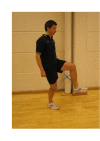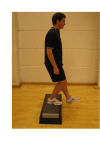Knee kinematics and kinetics in former soccer players with a 16-year-old ACL injury--the effects of twelve weeks of knee-specific training
- PMID: 17439651
- PMCID: PMC1865380
- DOI: 10.1186/1471-2474-8-35
Knee kinematics and kinetics in former soccer players with a 16-year-old ACL injury--the effects of twelve weeks of knee-specific training
Abstract
Background: Training of neuromuscular control has become increasingly important and plays a major role in rehabilitation of subjects with an injury to the anterior cruciate ligament (ACL). Little is known, however, of the influence of this training on knee stiffness during loading. Increased knee stiffness occurs as a loading strategy of ACL-injured subjects and is associated with increased joint contact forces. Increased or altered joint loads contribute to the development of osteoarthritis.The aim of the study was to determine if knee stiffness, defined by changes in knee kinetics and kinematics of gait, step activity and cross-over hop could be reduced through a knee-specific 12-week training programme.
Methods: A 3-dimensional motion analysis system (VICON) and a force plate (AMTI) were used to calculate knee kinetics and kinematics before and after 12 weeks of knee-specific training in 12 males recruited from a cohort with ACL injury 16 years earlier. Twelve uninjured males matched for age, sex, BMI and activity level served as a reference group. Self-reported patient-relevant data were obtained by the KOOS questionnaire.
Results: There were no significant changes in knee stiffness during gait and step activity after training. For the cross-over hop, increased peak knee flexion during landing (from 44 to 48 degrees, p = 0.031) and increased internal knee extensor moment (1.28 to 1.55 Nm/kg, p = 0.017) were seen after training, indicating reduced knee stiffness. The KOOS sport and recreation score improved from 70 to 77 (p = 0.005) and was significantly correlated with the changes in knee flexion during landing for the cross-over hop (r = 0.6, p = 0.039).
Conclusion: Knee-specific training improved lower extremity kinetics and kinematics, indicating reduced knee stiffness during demanding hop activity. Self-reported sport and recreational function correlated positively with the biomechanical changes supporting a clinical importance of the findings. Further studies are needed to confirm these results in women and in other ACL injured populations.
Figures








Similar articles
-
Knee kinematics and kinetics during gait, step and hop in males with a 16 years old ACL injury compared with matched controls.Knee Surg Sports Traumatol Arthrosc. 2006 Jun;14(6):546-54. doi: 10.1007/s00167-006-0071-4. Epub 2006 Mar 25. Knee Surg Sports Traumatol Arthrosc. 2006. PMID: 16565878
-
Biomechanical measures of neuromuscular control and valgus loading of the knee predict anterior cruciate ligament injury risk in female athletes: a prospective study.Am J Sports Med. 2005 Apr;33(4):492-501. doi: 10.1177/0363546504269591. Epub 2005 Feb 8. Am J Sports Med. 2005. PMID: 15722287
-
Biomechanics Associated with Patellofemoral Pain and ACL Injuries in Sports.Sports Med. 2015 Sep;45(9):1325-1337. doi: 10.1007/s40279-015-0353-4. Sports Med. 2015. PMID: 26130304 Review.
-
Kinematics and electromyography of landing preparation in vertical stop-jump: risks for noncontact anterior cruciate ligament injury.Am J Sports Med. 2007 Feb;35(2):235-41. doi: 10.1177/0363546506294077. Epub 2006 Nov 7. Am J Sports Med. 2007. PMID: 17092926
-
Prevention of non-contact anterior cruciate ligament injuries in soccer players. Part 2: a review of prevention programs aimed to modify risk factors and to reduce injury rates.Knee Surg Sports Traumatol Arthrosc. 2009 Aug;17(8):859-79. doi: 10.1007/s00167-009-0823-z. Epub 2009 Jun 9. Knee Surg Sports Traumatol Arthrosc. 2009. PMID: 19506834 Review.
Cited by
-
Kinematic Analysis of Gait Following Intra-articular Corticosteroid Injection into the Knee Joint with an Acute Exacerbation of Arthritis.Physiother Can. 2011 Fall;63(4):395-404. doi: 10.3138/ptc.2010-26. Epub 2011 Oct 20. Physiother Can. 2011. PMID: 22942516 Free PMC article.
-
Tibiofemoral Osteoarthritis After Surgical or Nonsurgical Treatment of Anterior Cruciate Ligament Rupture: A Systematic Review.J Athl Train. 2017 Jun 2;52(6):507-517. doi: 10.4085/1062-6050-49.3.89. Epub 2015 Jun 26. J Athl Train. 2017. PMID: 25562459 Free PMC article.
-
Lower Limb Asymmetry After Anterior Cruciate Ligament Reconstruction in Adolescent Athletes: A Systematic Review and Meta-Analysis.J Athl Train. 2020 Aug 1;55(8):811-825. doi: 10.4085/1062-6050-0244-19. J Athl Train. 2020. PMID: 32607546 Free PMC article.
-
Effect of Anterior Tibiofemoral Glides on Knee Extension during Gait in Patients with Decreased Range of Motion after Anterior Cruciate Ligament Reconstruction.Physiother Can. 2010 Summer;62(3):235-41. doi: 10.3138/physio.62.3.235. Epub 2010 Jul 23. Physiother Can. 2010. PMID: 21629602 Free PMC article.
-
Changes in landing mechanics in patients following anterior cruciate ligament reconstruction when wearing an extension constraint knee brace.Sports Health. 2014 May;6(3):203-9. doi: 10.1177/1941738114524910. Sports Health. 2014. PMID: 24790689 Free PMC article.
References
-
- Buss DD, Min R, Skyhar M, Galinat B, Warren RF, Wickiewicz TL. Nonoperative treatment of acute anterior cruciate ligament injuries in a selected group of patients. Am J Sports Med. 1995;23:160–165. - PubMed
-
- Daniel DM, Stone ML, Dobson BE, Fithian DC, Rossman DJ, Kaufman KR. Fate of the ACL injured patient: A prospective outcome study. The American Journal of Sports Medicine. 1994;22:632–644. - PubMed
-
- Fitzgerald KG, Axe MJ, Snyder-mackler L. The efficacy of perturbation training in nonoperative anterior cruciate ligament rehabilitation programs for physically active individuals. Physical Therapy. 2000;80:128–151. - PubMed
-
- Lephart SM, Henry TJ. Functional rehabilitation for the upper and lower extremity. Orthop Clin North Am. 1995;26:579–592. - PubMed
Publication types
MeSH terms
LinkOut - more resources
Full Text Sources
Medical

